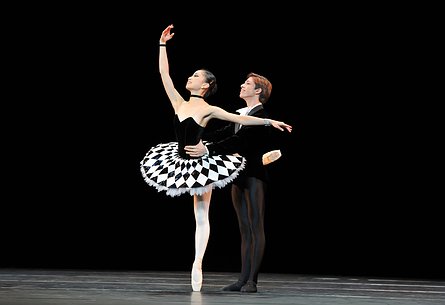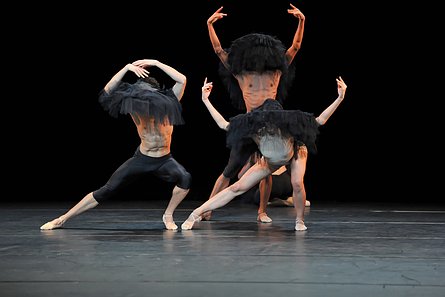Academy of Dance
SATANELLA Grand Pas de Deux
Music: Cesare Pugni
Choreography: Marius Petipa
Production: Birgit Keil
Dance: Moeka Katsuki, Pablo dos Santos
TUTU
Music: Arvo Pårt, Fratres
Choreography: Florian Lochner
Dance: Norma Magalhães, Pablo dos Santos, Juliano Pereira, Douglas de Almeida Lima
Photos SATANELLE and TUTU
In the frame of the examination with Dance Heritage we became aware once more of our responsibility for Classical Dance. How is the classical repertoire danced today? How is it getting interpreted and valued? How do young dancers answer when they accept their inheritance? It seems to be doubtless that a dancer can only put him/herself to the context in accepting the inhertitance. Heritage as a challenge for example through the study of SATANELLA (Grand Pas de Deux), which receives it's value through the present. Tradition turns to life.
The reflection of classical dance through the magnifying lens on the embodiment of the classical costume: the TUTU - a symbol - that allocates emotions. These are the feelings of coming generations of dancers. Heritage is passed on, responsibility is accepted and that keeps the classical dance alive.
The Choreography „TUTU“ is the master piece by Florian Lochner, who graduated in 2011 at Academy of Dance. He has been engaged by Eric Gauthier for the season 2011/12 for Gauthier Dance (Dance Company Theaterhaus Stuttgart). Florian Lochner was stipendiary of Tanzstiftung Birgit Keil Stuttgart.
We can only guide a way to future if we experience the present counciously and if we can draw from the past.
Since the year 1717 dance care is seized on records in Mannheim. Elector Karl Theodor was the one, who turned Mannheim to one of the outstanding cultural centres of German Reich some decades later:
The Opera house that has been opened in 1742 drawed artists in, as the choreographer Charles Gardel or the dancer's family Lauchery. The novel dramatic acting ballet could be developed thanks to the Mannheim music colleagues Cannabich, Toeschi and Fränzl (Representatives of "Mannheimer Schule").
Thanks to André Bouqueton, who was a choreographer at the electoral theatre, the first european dance academy has been built up in 1762 - even before Vienna, Milan or Saint Petersburg.
The institution's goal was to support local young dancers and to cover the personnel requirement of the ballets. The relocation of the electorial residence to Munich meant as well the relocation of the focus of the national theatre to drama. Dance has been practiced in private circles and schools. New highlights came up by the end of 19th century through Louise Dänike, Rudolf von Laban, Mary Wigman and Lisa Kretschmar. During their function Academy of Dance arose at the National University for Music and Dance in 1971. Because of the continuous growth of Academy of Dance's prestige it got necessary to move to new premises, which happened under the directon of Birgit Keil, former prima ballerina of Stuttgart ballet, in 1999. The heritage to support the local youth is put to present by the development of a pre-study. National and international young dancers can be supported financially thanks to Tanzstiftung Birgit Keil Stuttgart.
Lived and experienced dance art is safed for the curricula vitae - two different styles: the contemporary/classic-academic education and the contemporary/modern education set important courses. The individual artistic personality is developed with the students and supported by cooperations with Badisches Staatstheater Karlsruhe, Nationaltheater Mannheim and regulraly guest performances with the repertoire of Academy of Dance.
Students in Mannheim grow with reality, which is an important claim for today's dancers. Regular invitations from choreographers challenge the students as much as the training in handling their own creativity. The performances of Academy of Dance as a mirror of our dance heritage or engagements at well known Opera houses as well national as abroad, conduce the graduates to the accuracy of our credo.
The lived dance heritage takes places every day in our classes with the breathing in before every Plié, the Allongé, that should reach deep withing our roots.
Video samples of the presentations from SATANELLA and TUTU
INFORMATION ABOUT THE INSTITUTION


